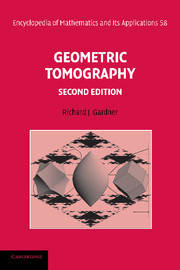Book contents
- Frontmatter
- Contents
- Preface to the second edition
- Preface
- 0 Background material
- 1 Parallel X-rays of planar convex bodies
- 2 Parallel X-rays in n dimensions
- 3 Projections and projection functions
- 4 Projection bodies and volume inequalities
- 5 Point X-rays
- 6 Chord functions and equichordal problems
- 7 Sections, section functions, and point X-rays
- 8 Intersection bodies and volume inequalities
- 9 Estimates from projection and section functions
- Appendixes
- References
- Notation
- Author index
- Subject index
7 - Sections, section functions, and point X-rays
Published online by Cambridge University Press: 05 June 2013
- Frontmatter
- Contents
- Preface to the second edition
- Preface
- 0 Background material
- 1 Parallel X-rays of planar convex bodies
- 2 Parallel X-rays in n dimensions
- 3 Projections and projection functions
- 4 Projection bodies and volume inequalities
- 5 Point X-rays
- 6 Chord functions and equichordal problems
- 7 Sections, section functions, and point X-rays
- 8 Intersection bodies and volume inequalities
- 9 Estimates from projection and section functions
- Appendixes
- References
- Notation
- Author index
- Subject index
Summary
The various themes explored in earlier chapters have both synthesis and counterpoint in this one. Just as Chapter 3 examined inverse problems where the given data involve orthogonal projections, so this chapter deals with information about sections through one or more points.
Much of the first section mirrors Section 3.1. Though star bodies would be the natural objects to consider, we have had to retreat to convexity for lack of more general results. For example, Theorem 7.1.9 implies that two convex bodies in En, n ≥ 3, must be homothetic if their intersections with any hyperplane through the origin are also homothetic. In the realm of convex bodies, a useful duality is provided by polar bodies (see Section 0.8). Via (0.38), this sometimes enables one to convert a theorem concerning projections to one about sections through the origin, or vice versa. We apply this technique in Theorem 7.1.11, which shows that “homothetic” cannot be replaced by “similar” in the foregoing statement. Unfortunately polar duality is of limited relevance in geometric tomography (cf. the last paragraph of Section 0.8), and we can only apply it on a couple of occasions. This means that separate proofs usually have to be constructed, even when there is a direct analogy with a result in Chapter 3. Moreover, the “mirror” is imperfect; for example, Theorem 7.1.9 actually draws the stronger conclusion that the bodies must either be dilatates or homothetic ellipsoids. Similarly, Theorem 7.1.10, sometimes called the false center theorem, states that if the intersection of a convex body with any hyperplane through the origin is centrally symmetric, the body must either be centered or an ellipsoid.
- Type
- Chapter
- Information
- Geometric Tomography , pp. 269 - 303Publisher: Cambridge University PressPrint publication year: 2006



